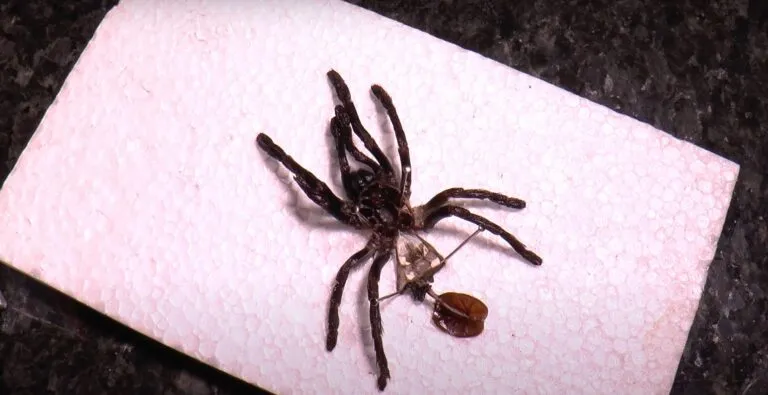Understanding Tarantula Sexing
Sexing a tarantula, or determining its gender, is a crucial skill for any tarantula keeper. Whether you are interested in breeding, anticipating changes in your pet’s behavior, or simply curious about the biology of your eight-legged friend, knowing how to tell a male from a female tarantula is essential. Several methods can be used, each with its own level of accuracy and ease of application. This guide will provide you with the fundamental techniques and insights to confidently identify the gender of your tarantula. This will help you learn the basics of tarantula sexing, empowering you to better understand and care for your pet.
Why Is It Important to Know the Gender?
Knowing the gender of your tarantula is important for several reasons, especially for responsible tarantula keeping. If you are considering breeding tarantulas, sexing is absolutely critical. Only females can produce eggs, and you will need to accurately identify a female to begin the breeding process. Males and females also have different lifespans and sometimes exhibit different behaviors. Males often have shorter lifespans, particularly after reaching maturity, while females can live for many years. Behaviorally, males may wander more frequently in search of a mate, and females might be more sedentary unless gravid. Furthermore, understanding your tarantula’s gender can provide insights into potential health issues and inform your overall care strategy.
5 Quick Tips to Determine Tarantula Gender

Identifying the gender of a tarantula can be done using several methods. While none of them are 100% foolproof, particularly with juveniles, a combination of these techniques significantly increases your accuracy. Remember, the best approach is to use multiple methods and, when possible, consult with experienced keepers. This section outlines five key methods you can employ to sex your tarantula at home. The most reliable methods typically involve examining the molted exoskeletons of the tarantulas. However, other visual cues such as the abdomen, the pedipalps, and the size of the tarantula can provide helpful clues.
Examine the Abdomen
Examining the abdomen is a common method of tarantula sexing, most effective after the tarantula has molted a few times. The presence or absence of certain features can indicate the gender. In females, the presence of spermathecae, a pair of sacs, is a key indicator, though these are not always easily visible in juveniles. The abdomen of males does not have this feature. Additionally, the shape of the abdomen can sometimes offer clues. Females often have rounder abdomens, especially when they are well-fed or gravid. A careful inspection of the underside of the abdomen, with good lighting and possibly magnification, can help reveal these differences. Be very careful when handling the tarantula, and prioritize the safety of the tarantula above all.
Look for Spermathecae (Females)
Spermathecae are the most definitive indicator of a female tarantula. These are internal structures located within the abdomen, visible on the molt. When you examine the shed exoskeleton of a tarantula, carefully look for the presence of the spermathecae. These appear as a pair of sacs or pouches, varying slightly in shape and size depending on the species. Finding spermathecae on a molt confirms that the tarantula is female. This method is highly reliable, but only works after the tarantula has molted. In young tarantulas or those that have not molted recently, it might not be possible to view the spermathecae clearly.
Check for Bulbs on the Pedipalps (Males)

Male tarantulas develop specialized structures called pedipalps, which are essentially small appendages near their mouths, used for mating. After the final molt, mature males will have these pedipalps modified into mating structures, which appear as bulbous or swollen tips. These ‘bulbs’ are filled with sperm. If you see these bulbs, it’s a clear indication that the tarantula is a mature male. This method is only applicable to mature males, meaning it is not useful for sexing juveniles. The presence of these bulbs is a reliable sign, indicating the tarantula’s gender, especially after the final molt.
Consider Molt Analysis
Molt analysis is perhaps the most reliable method for sexing tarantulas, especially with sub-adults and adults. After a tarantula molts, its exoskeleton is a valuable tool for gender identification. Lay the molt flat and examine the underside of the abdomen with a magnifying glass or microscope. Look for the presence of spermathecae in females or lack of it. If it’s a male, the pedipalps will remain unmodified until its final molt. With this method, patience is key, because you can’t sex a tarantula without access to its molt. The molts of young tarantulas might be too small for accurate examination. Carefully preserve the molts for gender analysis.
Observe the Overall Size and Appearance
While not always a definitive indicator, the overall size and appearance can sometimes hint at the gender of the tarantula. In many species, females tend to grow larger and have stouter bodies compared to males, especially after reaching adulthood. Males typically reach maturity sooner, often having a slender appearance. But, this method is less reliable because size can vary due to factors like feeding habits and genetics. Comparing the size and proportions to other tarantulas of the same species can offer some clues. However, this method is better used in conjunction with more definitive ones like molt analysis. The best way to determine gender is through direct inspection of the tarantula’s molts.
Consult with Experts or Breeders

If you are unsure about sexing your tarantula, don’t hesitate to seek expert advice. Experienced tarantula breeders and keepers have the expertise to accurately identify the gender of your tarantula. They can provide valuable insights, especially if you are struggling to interpret the visual cues. You can often find experienced keepers at local reptile shows, online forums, or through specialized pet stores. Provide clear pictures of the tarantula, including its underside and any available molts, and they can often help you with the identification. Consulting an expert is especially helpful when you are dealing with a juvenile tarantula or a species where gender identification is more challenging.
Conclusion
Knowing how to tell the gender of your tarantula is a key aspect of responsible tarantula keeping. While no single method is foolproof, utilizing a combination of techniques significantly increases your accuracy. By carefully examining the abdomen and the pedipalps, and by analyzing molts, you can often determine the gender of your tarantula. Remember to combine observations with the help of experienced keepers and always prioritize the well-being of your pet. As you become more proficient in tarantula sexing, you’ll enhance your ability to care for and appreciate these fascinating creatures. With practice and attention to detail, you will be well-equipped to understand your tarantula’s gender and provide the best possible care.
